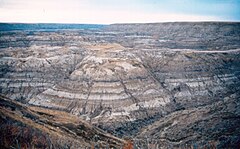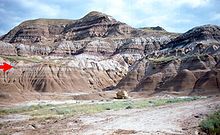Horseshoe Canyon Formation
| Horseshoe Canyon Formation | |
|---|---|
| Stratigraphic range: | |
 Horseshoe Canyon Formation at its type locality in Horseshoe Canyon, near Drumheller. The dark bands are coal seams. | |
| Type | Geological formation |
| Unit of | Edmonton Group |
| Underlies | Whitemud Formation |
| Overlies | Bearpaw Formation |
| Thickness | Template:M to ft[1] |
| Lithology | |
| Primary | sandstone |
| Other | shale, coal |
| Location | |
| Coordinates | 51°25′24″N 112°53′18″W / 51.42333°N 112.88833°W |
| Region | Western Canadian Sedimentary Basin |
| Country | |
| Type section | |
| Named for | Horseshoe Canyon |
| Named by | E.J.W. Irish, 1970 |
The Horseshoe Canyon Formation is part of the Edmonton Group and is up to 230m in thickness. It is Late Campanian to Early Maastrichtian in age (Edmontonian Land Mammal Age) and is composed of mudstone, sandstone, and carbonaceous shales. There are a variety of environments represented by the succession, including floodplains, estuarine channels, and coalswamps, which have yielded a diversity of fossil material. Tidally-influenced estuarine point bar deposits are easily recongizable as Inclined Heterolithic Stratification (IHS). Brackish-water trace fossil assemblages occur within these bar deposits and demonstrate periodic incursion of marine waters into the estuaries. The Horseshoe Canyon Formation crops out extensively in the area of Drumheller, Alberta, as well as further north along the Red Deer River near Trochu, and also in the city of Edmonton. It is overlain by the Battle, Whitemud, and Scollard formations. The Drumheller Coal Zone, located in the lower part of the Horseshoe Canyon Formation, has been a primary CBM target for industry. In the area between Bashaw and Rockyford, the Drumheller Coal Zone is relatively shallow (about 300 metres) with 10 to 20 metres cumulative coal within a 70 to 120 metre coal zone thickness. The coal zone may contain 20 or more individual thin seams and interbedded sandstone and shale, which combine to make an attractive multi-completion CBM target for drilling companies. In total, it is estimated there are 14 trillion cubic metres (500 tcf) of gas in place in all the coal in Alberta.

Dinosaurs found in the Horseshoe Canyon Formation include Albertosaurus, Anchiceratops, Arrhinoceratops, Atrociraptor, Chirostenotes, Dromiceiomimus, Edmontonia, Edmontosaurus, Euoplocephalus, Hypacrosaurus, Ornithomimus, Pachyrhinosaurus, Parksosaurus, Saurolophus, Stegoceras, Struthiomimus and Troodon. Other finds have included mammals such as Didelphodon coyi, non-dinosaur reptiles, amphibians, fish, marine and terrestrial invertebrates and plant fossils. Reptiles such as turtles and crocodilians are rare in the Horseshoe Canyon Formation, and this is thought to reflect the relatively cool climate which prevailed at the time.
Horseshoe Canyon itself is located 17 km southwest of Drumheller, Alberta, Canada, on Highway 9. This Canyon gets its name from its horseshoe shape and is approximately 3 km long, extending from Highway 9 to Kneehill Creek area.
Oil/gas production
Coalbed methane is extracted from the Horseshoe Canyon Formation in Southern Alberta.
Dinosaurs
Ankylosaurs
| Ornithischians reported from the Horseshoe Canyon Formation | ||||||
|---|---|---|---|---|---|---|
| Genus | Species | Location | Stratigraphic position | Material | Notes | Images |
|
E. longiceps |
 | |||||
|
E. tutus |
||||||
Maniraptors
| Maniraptors reported from the Horseshoe Canyon Formation | ||||||
|---|---|---|---|---|---|---|
| Genus | Species | Location | Stratigraphic position | Material | Notes | Images |
|
A. borealis |
Limb bones, type specimen |
An alvarezsaurid |
||||
|
A. marshalli |
Partial skull, type specimen |
A dromaeosaurid | ||||
|
C. pergracilis |
A second metatarsal catalogued as NMC 2570.[2] |
A caenagnathid | ||||
|
Indeterminate |
Teeth |
A dromaeosaurid | ||||
|
Indeterminate |
Teeth |
An indeterminate maniraptoran | ||||
|
R. gilmorei |
Teeth |
A dromaeosaurid | ||||
|
R. isosceles |
Teeth |
|||||
|
Indeterminate |
Teeth |
A dromaeosaurid | ||||
|
Indeterminate |
Teeth |
A troodontid | ||||
Marginocephalians
| Marginocephalians reported from the Horseshoe Canyon Formation | ||||||
|---|---|---|---|---|---|---|
| Genus | Species | Location | Stratigraphic position | Material | Notes | Images |
|
A. ornatus |
  | |||||
|
A. brachyops |
"Complete skull."[3] |
|||||
|
E. xerinsularis |
Found within the upper 20 m of the formation. |
|||||
|
P. canadensis |
Upper unit 1 |
Ceratopsids | ||||
|
P. lakustai |
Lower unit 1 |
|||||
|
S. edmontonense |
||||||
Ornithomimids
Color key
|
Notes Uncertain or tentative taxa are in small text; |
| Ornithomimids reported from the Horseshoe Canyon Formation | ||||||
|---|---|---|---|---|---|---|
| Genus | Species | Location | Stratigraphic position | Material | Notes | Images |
|
D. brevitertius |
Junior synonym of Ornithomimus edmontonicus. |
 | ||||
|
O. brevitertius |
Junior synonym of O. edmontonicus | |||||
|
O. currellii |
Junior synonym of O. edmontonicus | |||||
|
O. edmontonicus |
Several specimens, type specimen |
An ornithomimid | ||||
|
O. velox |
Misclassified, now considered Struthiomimus sp. | |||||
|
Indeterminate |
An ornithomimid | |||||
|
S. brevitertius |
Junior synonym of Ornithomimus edmontonicus | |||||
|
S. currellii |
Junior synonym of Ornithomimus edmontonicus | |||||
|
S. ingens |
Junior synonym of Ornithomimus edmontonicus | |||||
Ornithopods
| Ornithopods reported from the Horseshoe Canyon Formation | ||||||
|---|---|---|---|---|---|---|
| Genus | Species | Location | Stratigraphic position | Material | Notes | Images |
|
E. regalis |
  | |||||
|
H. altispinus |
"[Five to ten] articulated skulls, some associated with postcrania, isolated skull elements, isolated postcranial elements, many individuals, embryo to adult."[4] |
|||||
|
P. warrenae |
||||||
|
S. osborni |
"Complete skull and skeleton, [two] complete skulls."[4] |
|||||
Tyrannosaurs
Color key
|
Notes Uncertain or tentative taxa are in small text; |
| Theropods reported from the Horseshoe Canyon Formation | ||||||
|---|---|---|---|---|---|---|
| Genus | Species | Location | Stratigraphic position | Material | Notes | Images |
|
A. arctunguis |
Junior synonym of A. sarcophagus |
 | ||||
|
A. sarcophagus |
Several skeletons and partial skeletons, type specimen |
A tyrannosaurid | ||||
|
Indeterminate |
Bonebed |
A tyrannosaurid, may represent Albertosaurus sarcophagus | ||||
|
D. arctunguis |
Junior synonym of Albertosaurus sarcophagus | |||||
|
D. sarcophagus |
Junior synonym of Albertosaurus sarcophagus | |||||
|
D. incrassetus (formerly Laelaps) |
Teeth |
Nomen dubium | ||||
See also
Footnotes
References
- Varricchio, D. J. 2001. Late Cretaceous oviraptorosaur (Theropoda) dinosaurs from Montana. pp. 42–57 in D. H. Tanke and K. Carpenter (eds.), Mesozoic Vertebrate Life. Indiana University Press, Indianapolis, Indiana.
- Weishampel, David B.; Dodson, Peter; and Osmólska, Halszka (eds.): The Dinosauria, 2nd, Berkeley: University of California Press. 861 pp. ISBN 0-520-24209-2.
